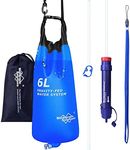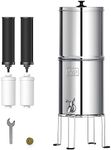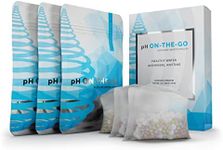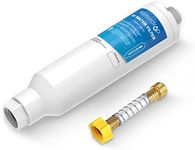Buying Guide for the Best Gravity Water Filter
Choosing a gravity water filter is all about finding a balance between your water purification needs, the size of your household or group, and how portable or permanent you want your setup to be. Gravity water filters are popular because they don’t require electricity or complicated installation, making them great for home use, camping, or emergency preparedness. To pick the best one for you, it’s important to understand the main features and how they relate to your lifestyle and water quality concerns.Filtration CapacityFiltration capacity refers to how much water the filter can process before the filter element needs to be replaced. This is important because it determines how often you’ll need to buy new filters and how suitable the filter is for long-term use. Some filters are designed for a few hundred gallons, while others can handle thousands. If you plan to use the filter daily for a family, a higher capacity is better. For occasional use or travel, a lower capacity may be sufficient.
Filter Media TypeThe filter media is the material inside the filter that actually removes contaminants. Common types include ceramic, activated carbon, and composite filters. Each type targets different impurities: ceramic is good for bacteria and protozoa, carbon is effective against chemicals and bad tastes, and composite filters often combine benefits. If your water source is questionable or untreated, look for filters that handle bacteria and protozoa. If you’re mainly concerned about taste or chemicals, carbon-based filters are a good choice.
Contaminant RemovalThis spec tells you what kinds of contaminants the filter can remove, such as bacteria, viruses, protozoa, heavy metals, or chemicals. It’s important because not all filters remove all types of contaminants. If you’re using the filter for outdoor water or emergency situations, choose one that removes bacteria and protozoa at a minimum. For tap water, focus on filters that reduce chemicals, chlorine, and heavy metals. Always match the filter’s capabilities to the risks in your water source.
Flow RateFlow rate measures how quickly the filter can produce clean water, usually in liters or gallons per hour. This matters if you need water for several people or want to avoid waiting a long time. Lower flow rates are common in more thorough filters, while higher flow rates are convenient but may not filter as finely. If you’re filtering water for a group or family, a higher flow rate is helpful. For solo or occasional use, a slower rate may be acceptable.
Tank SizeTank size refers to how much water the filter can hold at one time, both in the upper (unfiltered) and lower (filtered) chambers. This is important for convenience—larger tanks mean you can filter more water at once without constant refilling. For home or group use, a larger tank is practical. For travel or solo use, a smaller, more portable tank is easier to manage.
PortabilityPortability is about how easy it is to move or transport the filter. Some gravity filters are lightweight and designed for camping or travel, while others are heavier and meant to stay in one place. If you need a filter for outdoor adventures or emergencies, look for compact, lightweight models. For home or basecamp use, a larger, sturdier filter may be more suitable.
Ease of Cleaning and MaintenanceThis spec covers how simple it is to clean the filter and replace its parts. Some filters require regular scrubbing or backwashing, while others have disposable cartridges. If you want low maintenance, look for filters with easy-to-replace elements and simple cleaning instructions. If you don’t mind a bit of upkeep, more thorough filters may need occasional manual cleaning.















![[New Upgraded Ultrafiltration] AQUACREST Black Water Filter, Replacement for Berkey® BB9-2® Black Purification Elements, Berkey® Gravity Water Filter System, 2 Pack](https://images-proxy.bestreviews.guide/6UrWXMD2rOhm3AKHxlcsoF8acaE=/0x150/https://m.media-amazon.com/images/I/319KHGo+CLL._AC_CX679_.jpg)
